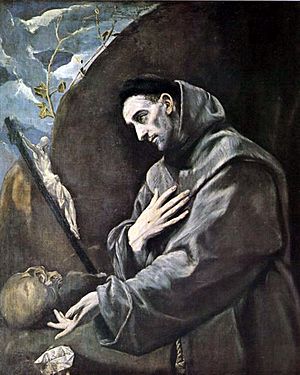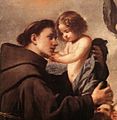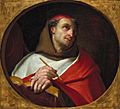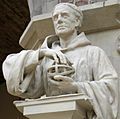Franciscan facts for kids

A Franciscan is someone who follows the teachings of Saint Francis of Assisi. He lived in the 13th century and started a special way of life. Franciscans usually choose to live very simply, often without much money. Today, there are three main groups of Franciscans. Most of them are part of the Roman Catholic or Anglican Church. Some smaller groups are also found in the Old Catholic and Protestant Churches.
Contents
Who Are the Franciscans?
Franciscans are members of religious orders that follow the rules set by Saint Francis. These rules guide them to live a life focused on poverty, humility, and serving others. They believe in living close to nature and helping those in need.
The Founder: Saint Francis of Assisi
Saint Francis of Assisi was born in Assisi, Italy, around 1181 or 1182. He came from a wealthy family but decided to give up his riches to live a life dedicated to God and helping the poor. He believed in treating all people and creatures with love and respect. Francis started the first Franciscan order in 1209.
How Franciscans Live Their Lives
Franciscans are known for their simple lifestyle. They often take vows of poverty, meaning they do not own much personal property. They also promise to live in obedience and chastity. Many Franciscans work in communities, helping the poor, sick, and needy. They might also teach, preach, or work as missionaries. Their goal is to follow the example of Saint Francis, living humbly and serving God through serving others.
Different Branches of Franciscans
Over time, the Franciscan movement grew and developed into different branches. The three main groups today are:
- Order of Friars Minor: These are the male Franciscans, often called friars. They live in communities and work in various ministries.
- Poor Clares: This is an order for women, founded by Clare of Assisi, a close friend of Saint Francis. They live a contemplative life, often in monasteries, focusing on prayer.
- Third Order of Saint Francis: This group includes both men and women, married or single, who live in the world but follow Franciscan values. They might be lay people or members of religious communities.
These different branches all share the same core beliefs inspired by Saint Francis, but they live them out in slightly different ways.
Important Franciscan People and Places
Many famous and influential people have been Franciscans throughout history. They have contributed to Christianity, education, and helping communities around the world.
Notable Franciscans
- Anthony of Padua (1195–1231): A famous preacher and teacher.
- Bonaventure (1221–1274): A great theologian and leader of the Franciscan order.
- Roger Bacon (c. 1214–1294): An English philosopher and scientist who was a Franciscan friar.
- Bernardino of Siena (1380–1440): A popular preacher known for spreading devotion to the Holy Name of Jesus.
- Mary Frances Schervier (1819–1876): She founded the Poor Sisters of St. Francis to serve the needy.
Franciscan Buildings and Communities
Franciscans have built many beautiful monasteries, churches, and convents around the world. These places serve as centers for prayer, community life, and outreach. You can find Franciscan communities in many countries, continuing their work of service and faith.
Images for kids
-
Saint Francis Comforted by a Musician Angel, by Francisco Ribalta.
-
Regula bullata, the rule confirmed by Pope Honorius III
-
The Confirmation of the Franciscan Rule by Domenico Ghirlandaio (1449–1494), Capella Sassetti, Florence
-
Honorius III Approving the Rule of St. Francis of Assisi, Bartolome del Castro, c. 1500 (Philadelphia Museum of Art)
-
Anthony of Padua (c. 1195–1231) with the Infant Christ, painting by Antonio de Pereda (c. 1611–1678)
-
Bonaventure (1221–1274), painting by Claude François (c. 1650–1660)
-
Franciscan convent at Lopud in Croatia
-
Clare of Assisi (1194–1253), founder of the Poor Clares, in a painting by Simone Martini (1284–1344) in the Basilica of San Francesco d'Assisi
-
Luchesius Modestini, honored as the first Franciscan tertiary
-
The stigmatization of St. Francis
-
Roger Bacon (c. 1214–1294), statue from the 19th century in the Oxford University Museum of Natural History
-
Bernardino of Siena (1380–1440), painted by Jacopo Bellini (c. 1400–1470)
See also
 In Spanish: Orden Franciscana para niños
In Spanish: Orden Franciscana para niños





















